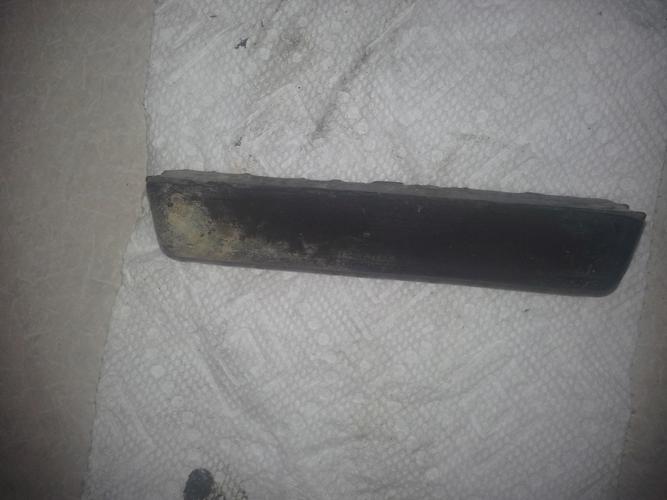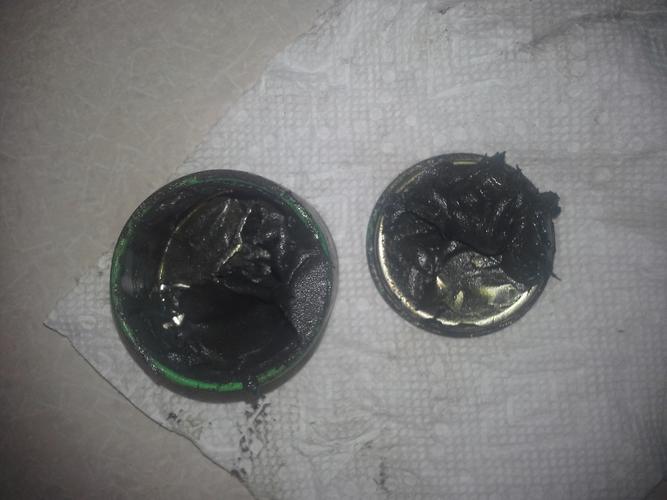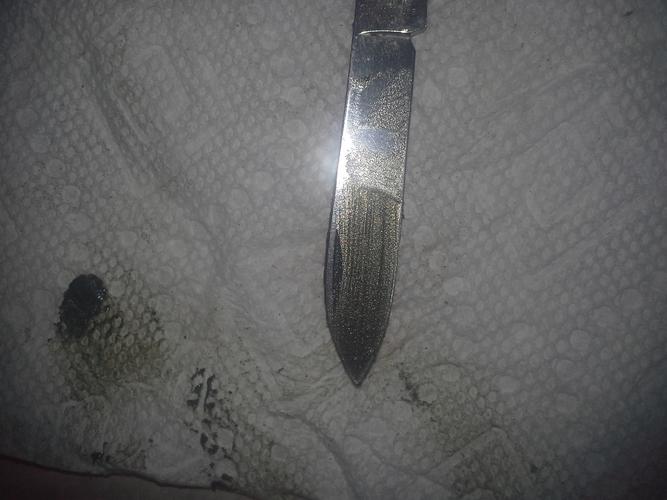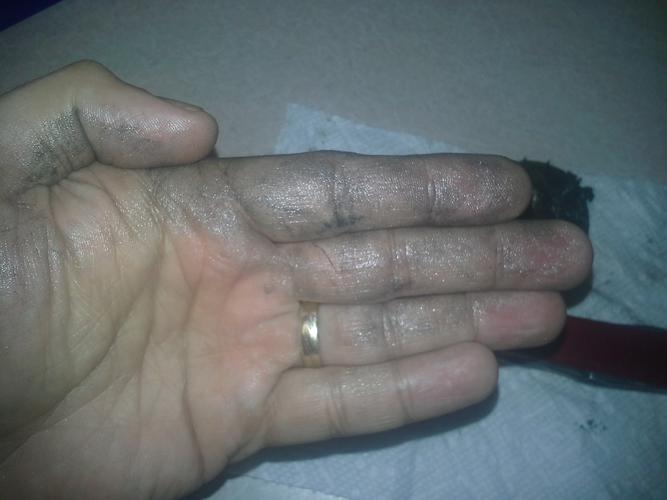Results 21 to 29 of 29
-
06-11-2014, 07:28 PM #21Senior Member


- Join Date
- Jul 2011
- Posts
- 2,110
Thanked: 459
Well, if the compound were on the back side of the strop, you literally could get by without ever honing the razor.
Once abrasive particles are suitably fine (as the crocus product he's talking about may be), it really doesn't matter how the edge is honed as long as it's not with great pressure.
Valve lapping compounds are in the 100-300 grit range, but crocus cloth is a very slow polishing compound that is much slower than something like autosol (which is 3 micron alumina). Presume the crocus they're talking about is a fine grade like a jewelers rouge, and if it had alumina in it back then, or crushed corundum, it very well may have maintained a razor just fine.Last edited by DaveW; 06-11-2014 at 07:35 PM.
-
06-12-2014, 12:25 PM #22Senior Member

- Join Date
- Sep 2013
- Location
- NW Indiana
- Posts
- 1,060
Thanked: 246
I'm a machinist and have used crocus. I'm pretty sure it's just FeO - Ferric Oxide - or rust. It's obviously not just scraped off a bumper, it's finely graded and only very small particles. Not a very fast abrasive and in the machining sphere the cloth strips are not useful for a whole lot other than polishing non-ferrous metals. The compound is useful for buffing steel with a wheel very fine though. I could see it working pretty well for a strop paste as long as you got a fine grade of powder or stick. Would take a heck of a lot longer to cut than CrO though.
-
06-12-2014, 02:55 PM #23Senior Member



- Join Date
- Apr 2008
- Location
- Essex, UK
- Posts
- 3,816
Thanked: 3164
If you back around 250 years, and more, you find that crocus and emery, together with glue, were some of the major consumables bought by the Sheffield edge-tool, knife and razor industries. Crocus and emery gave two very different finishes - known as 'crocus finish' and 'emery finish'.
Crocus finish was a mirror finish, with clear, bright reflections. A pretty hard wheel was used ('leather lap' - wood lapped with leather, usually walrus or seal hide because of its thickness) because material wheels left lines that were not called for in this type of finish. The wheel could also be a lead lap - wood bound with lead (gave a superior finish - before applying the crocus the lead was hatched with an old razor so it could hold a good charge). On these wheels the crocus was mixed with suet (animal fat) and/or beeswax, and 'bouldered' in - that is a smooth pebble (the boulder - a smooth translucent flint or pebble, about the size of a flattened hens egg) was used to press the crocus into the wheel - this reduced the abrasiveness of the crocus and smoothed the wheel at the same time.
The use of beeswax was to further flatten or deaden the emery or crocus - a finer finish was obtained in this way. Bouldering plus plenty of beeswax was the order of the day for lead laps and crocus mirror finishing.
Although long abandoned in Sheffield, the crocus finish was still used by some German cutlery firms - Giesen & Forsthoff spring to mind - as late as the 1950s.
Incidentally, the latin name 'crocus martis' has been used for almost any form of impure red coloured iron oxide or copperas (ferrous sulphate known from ancient times as green vitriol because of its blue green colour) from a very early time.
Glaze finish was achieved using emery. If you look closely at this type of finish you will see a multitude of tiny parallel lines - the sign of an authentic blue-glaze finish. A glazing wheel was leather (leather lap) and glue was used to stick the emery to it. I have made this type myself - they make a really fine cutting wheel, but unless the surface is lightly hit with a hammer to induce crazed cleavage lines into it bits are apt to fly off and embed themselves in you. You could get a glossier emery finish - this was achieved using very fine 'flower emery' mixed with suet (animal fat) and beeswax - it was known as 'flowering'.
Crocus is used again on a polishing wheel. It is smaller than a glazer or lead lap and revolves at a slower rate. It is made of wood lapped with leather, and dry crocus s dusted on it. This is the final stage of a crocus finish.
Crocus is indeed an oxide of iron. But there are a few types. It is not, for instance, 'jewellers rouge' which is an iron oxide. Jewellers rouge is used (the clue lies in the name!) by (gasp!) jewellers! It is only mildly abrasive but because it is so fine-cutting it is used on the soft metals regularly employed by jewellers (gold, silver) and gives a first-rate finish to them (as well as staining your hands, fingers and flying off everywhere - don't ask me how I know!) but it does not cut metal well enough to be used on it. Even among the jewellers rouges there are several degrees of powder/bar available, all with greater or lesser cutting power. The harder stuff could conceivably be used on steel, but the finish it gave would be coarser than true crocus.
There is another oxide of iron that is black in colour rather than red ('rouge') and this type is quite hard and can be used to cut iron and steel. The old crocus was much darker than modern rouge due to a high level of the black oxide in it and the red oxide beginning to turn black which has a kind of purple hue. Artisans making crocus would fire iron oxide in small crucibles, firing many at one time. It was found that at the bottom and edges of the crucible the crocus was darker - this was saved for the cutlery trades. In the middle it was red and softer - this was saved for jewellers.
At the time crocus and rouge was prepared in this way from a solution of sulphate of iron or copperas subjected to a high heat to drive of the acid and leave behind the lesser calcined rouge and the more calcined crocus. A little distinction, but it meant everything back in the day. In fact another way of making jewellers rouge was sometimes employed using peroxide of iron (ammonia + water + sulphate of iron), washing it thoroughly, squeezing all the water out by compressing it into cake and then leaving it on a low red heat before grinding.
So, it was a bit of an 'eyeball' process and I suspect the stuff varied from firing to firing.
Some people confuse emery with crocus - this is wrong, they are not the same. Emery is a mineral containing a very hard substance called corundum - aluminium oxide, together with other elements like rutile. The synthetic version may also contain magnesium and silica.
Bar crocus is simply crocus formed into a bar. It must have had something to hold it together that set fairly well and which could be dissolved with kerosene. Rio Grande jewellers supplies still sell 'bar crocus' but it is just rouge set into a bar with wax like other modern wheel-applied compounds.
Not one type of rag or cotton wheel was used in Sheffield - they blurred the edges of the workpiece too much. All wheels were relatively hard, from the sandstone grinding wheels, including the wooden lead and leather lapped glazing and polishing wheels. Sometimes, for bits like tangs, etc, the wood was used alone, unadorned with leather or lead.
Regards,
NeilLast edited by Neil Miller; 06-12-2014 at 03:01 PM.
-
-
06-13-2014, 01:57 AM #24Senior Member

- Join Date
- Apr 2014
- Location
- Southern MO
- Posts
- 215
Thanked: 31
Thanks Neil! excellent info.
-
06-13-2014, 02:15 AM #25

So in the back of workshop in a dusty box from the back of my grandfather's workshop in a dusty box, I have crocus circa 1935. One bar made with tallow and paste sealed in a metal can with kerosene. The box the bar was in is labeled 1938 and the price was 10 cents (US). The metal can I would guess was from the 1970s, had to pry it open with a screw driver, and reeked of kerosene. No price on it and only a masking tape label.
I'm including pictures for those of you that wanted to know what it looked like. (Assuming I attached them correctly)
Here is the block:

Here is the paste:

Here is the paste on a knife blade:

Here is what happens after you handle the block:
 Some people never go crazy. What truly horrible lives they must lead - Charles Bukowski
Some people never go crazy. What truly horrible lives they must lead - Charles Bukowski
-
The Following User Says Thank You to criswilson10 For This Useful Post:
bongo (06-13-2014)
-
06-13-2014, 08:10 AM #26Senior Member



- Join Date
- Apr 2008
- Location
- Essex, UK
- Posts
- 3,816
Thanked: 3164
That looks awfully like the tins of grease-bound 'Clova' lapping compound I have, made from emery flower (grey) rather than crocus (dark purplish red).
I think it goes all the way from a coarse 80 grit to an extra fine 2000 grit. But it is not true crocus, as crocus is not dark grey.
The only way I can conceive of it being called crocus is in the same way people loosely refer to vacuum cleaners as 'hoovers' when the fact of the matter is that although they all vacuum up dirt, only one brand is a Hoover.
Regards,
Neil
-
06-13-2014, 04:25 PM #27

The hard block is a deep purple - well the part that isn't moldy. The grit is very fine, I'd say around 10,000, maybe a bit higher or lower, but definitely above 8,000.
That is some nasty stuff that is hard to wash off and it smells like rancid leather. The stink didn't wash off easy either. I understand why people switched to other media.
You could be right about the paste not being true Crocus but being loosely referred to as crocus. That can definitely looks like a Clover Lapping Compound can. I would guess it is around 2000 grit. It smells of kerosene instead of the grease that Clover uses and it is darker blue than the grey 80 grit Clover compound that I have. It does appear to be iron oxide.
In the end I guess it is just a dusty hand labeled can of some kind of home made lapping paste. Now that it is out of the dusty box I'll use it up restoring a very beat up rusted wood chisel. I bar and its box are going into a ziplock bag and covered with silica dessicant to hopefully dry that smell out before buzzards start circling my workshop.Some people never go crazy. What truly horrible lives they must lead - Charles Bukowski
-
06-13-2014, 06:28 PM #28Senior Member



- Join Date
- Apr 2008
- Location
- Essex, UK
- Posts
- 3,816
Thanked: 3164
I reckon you are right about the tinned stuff, Cris, and the bar - it doesn't look purple on my monitor but you get an awful lot of colour casts and wrong colours from screen to screen. Yes, the bar must be crocus - the good, hard kind because of the colour.
I have a bar of compound that stinks too - as soon as it hits the wall it smells like a dead goat is in the workshop - that really 'goaty' smell, if you know what I mean. I went to a leather market in Egypt and the overall smell in the high heat was dog excrement and goat. Turns out they used the dog poo to tan the leather - break the fibres down. It was hard to nail down which was the most objectionable smell, especially since the traders had a smell all their own, too. I didn't buy anything.
I reckon the binder in your bar has gone off after all these years. Perhaps you could experiment with a cut off bit - use kerosene to dissolve it and pour off to leave the sludge, let dry, then melt into another binder, something like bobbing wax maybe. Not sure if I would have the courage to do that though!
Regards,
Neil
-
06-13-2014, 10:18 PM #29

I think I'm going to honor what I believe is a family tradition with this bar. I'm going to chunk it back into the dusty box and let the next generation find it.
 Some people never go crazy. What truly horrible lives they must lead - Charles Bukowski
Some people never go crazy. What truly horrible lives they must lead - Charles Bukowski


 37Likes
37Likes LinkBack URL
LinkBack URL About LinkBacks
About LinkBacks






 Reply With Quote
Reply With Quote
